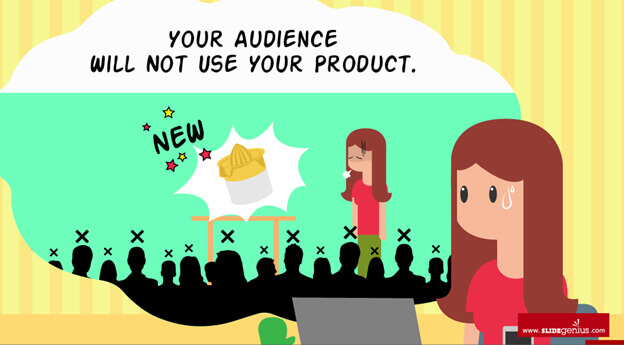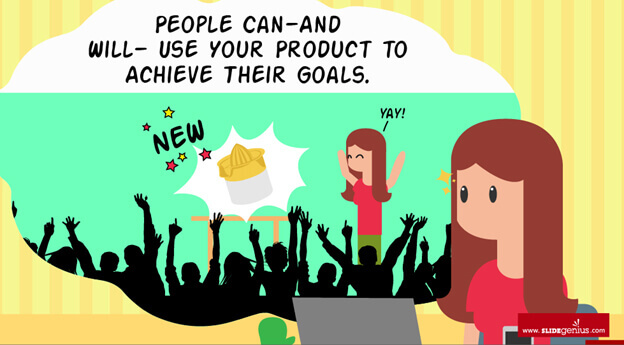4 Mindsets to Inspire Your Presentation
See also: Top Tips for Effective Presentations
Businesses exist to provide something to people. Be it product or service, when a person receives any form of benefit and/or comfort from a business, a transaction is deemed successful.
When they like it, they become repeat customers. But how do you make sure your customers keep coming back to you? You do this by satisfying their needs. In principle, this is why people buy into a business.
That is for your established targets, though. What about inviting other potential clients to connect with your business? By using the same principle, you can even include their “wants”. Aim to do this even at your pitches. Having the forethought to satisfy their immediate needs during your presentation—curiosity, mainly, along with interest—goes a long way. They’re still listening to you, aren’t they?
This is one example of catering your goals and beliefs to your target market. In presentations, being straightforward, outright, and honest about your own values—corporate or personal—will make you an object of empathy. This makes you relatable. When the audience connects with you and understands that your product could make their lives easier, your life and business, in return, will benefit.
Moreover, staying dynamic in your approach is crucial for maintaining audience engagement. Alongside effectively communicating your values, modern tools can also significantly contribute to impactful presentations. For instance, tools like Canva's free pdf to PowerPoint converter allows you to seamlessly transform your valuable content from PDFs to dynamic PowerPoint slides. This technological integration empowers you to convey your message in an engaging and versatile format, thereby captivating your audience's attention and enhancing their understanding.
Building the perfect presentation and crafting great copy take effort, time, and, inspiration. So where do you get the last?
Your product. You hold in your hands the lifeline of your business. How well you sell it will make or break your career as an entrepreneur.
Here are a few mindsets to help you kick-start that presentation while brainstorming for your pitch.
1. Your Product Should Deliver - and More

Your presentation should cover the basics: answering the what, how, when, and where of your product. Of course you will be showing it, discussing its appearance, features, and specifications through a video or a live demonstration that will help build your audience.
You will be presenting how it will solve problems and what curiosity or craving it satisfies. But there should be something more than that.
Why does your product exist? Why did you make it? You should aim to answer that: “the why.”
You have at least three questions in mind:
a) “Why did you make it?”
b) “Why should they buy it?” and
c) “Why should they choose it over your competitors’?”
In doing so, you get to identify, discuss, and demonstrate what problems your product can solve.
The last two questions address what makes you unique from competition. What’s in your product that rival companies don’t have? What can your product do that theirs can’t?
Taking your place above and beyond the competition is an important factor you should show your potential customers. Don’t keep what sets you apart from the others a secret. This may just be the edge you need to secure a solid market.
Giving your audiences the questions they’re subconsciously thinking of and the answers they’re unknowingly looking for will inspire them to buy your product.
2. Your Audience Doesn’t Know What They Want Until They See It

According to Steve Jobs, “A lot of times, people don’t know what they want until you show it to them.”
While many product-oriented companies, for example IBM, disagree and ask for feedback from their customers, Apple was one of the few who didn’t care about what consumers wanted because of the fact that they do not know what they want. Look at that success story.
This may be a good place for you to start when preparing to showcase your product. Somewhat related to the question above, “Why should they buy [your product],” you will show every innovation you have thought and included in your design—maybe even to the point that it becomes the industry changer.
In that sense, having the same mindset when designing your product is also beneficial, albeit absurdly difficult. Spending all that time and money to validate a device that may or may not be widely accepted, which in turn makes it a poor innovation idea and a failure in the eyes of people, is the risk that you have to take especially when starting from scratch without solid research and validation. But when that gamble works, you’re a hero.
In your presentation, do not show what is innovative about your product. Unless they’re not experts, they would’ve figured it out with just one look. Instead, show how it will be beneficial to them. That way, you justify your idea with practicality.
This style of innovation may push your creativity to the limits, but not heeding the voices of your target market can only take you so far. You can’t disregard customer feedback for so long, because ultimately, a major thing you can get from them—apart from their money, trust, and loyalty—is constructive feedback. They can point out problems they experienced with your product and report those issues to you; it’s up to you to fix it.
3. Your Audience Will Not Use Your Product

Let’s continue with the innovation mindset. You’re starting from scratch and ready to shell out money for the research and validation of your product.
How do you design it then?
With the mindset that no one, absolutely no one, will use your product. They will instead rely on other methods to get the result they want (which your product proposes) without getting what you offer. That’s when you decide to create a product they cannot ignore.
Setting this low standard upon yourself will test your determination, starting from the designing of your product to its pitching, to come up with something greater and better than you have done before. Instead of setting yourself up for greatness and facing an arbitrary wall that is pressure, set yourself up for greatness by starting with the small things.
The same principle goes when creating your pitch. You already plowed through the low expectations you had when starting out; what’s stopping you from doing the same to the follow statement: “No one will listen to this product pitch because it’s boring.”
4. People Can - and Will - Use Your Product to Achieve Their Goals

Let’s go to the reverse of the third point above. Having high expectations of your product will lead you to designing and creating a better result, something that will help people not only to their convenience but also to their inconvenience.
This is called the Pygmalion effect. The high standards you set will bring out your potential in designing your product—and, down the line, crafting your pitch. Meeting that expectation may take a lot out of you, but the rewards will definitely be worth it. It’s another type of gamble, sure, but you’ve risked more when you started out.
The whole concept is easy to understand, especially when you consider what you’ve done to get to this point. You’ve done your best since the beginning; continue that. What’s stopping you?
Nailing a great presentation, one that will wow your audience, is gruelling work. With many things to consider when preparing, like how you look or sound, your PowerPoint presentation should at least be the one thing you’re not worried about. You’ve already got too much to handle while waiting for your turn to speak.
You don’t have to be a visual expert when creating your deck. You can get inspiration from an unlikely source: your product. Try thinking of a few ideas when crafting the perfect presentation visual aid. Your product should do more than deliver what you say it will do. This will interest and engage your audience, especially when you answer “the why.” Show them how innovative your product is and how it will be a great help. Lower your standards so that you can create something better than you have ever imagined. Lastly, and alternatively, set high expectations that can influence the output you will eventually finish.
Don’t worry about mental blocks. At this point, they may not be much of a bother for you. You’ve already got your eyes on your goal, and you’ve started your journey years ago. Keep on going. It’s the only direction you will want to take.

About the Author
Rick Enrico is the CEO and Founder of SlideGenius, Inc.
He regularly publishes expert presentation tips on the SlideGenius blog.
